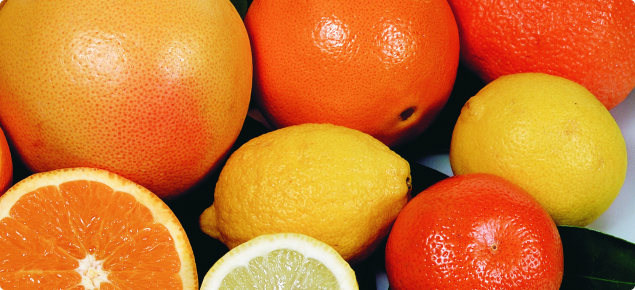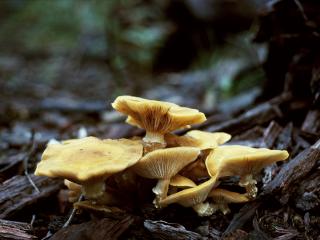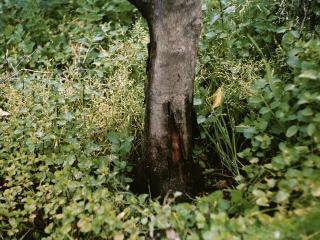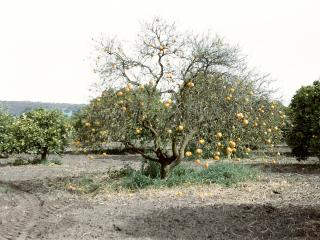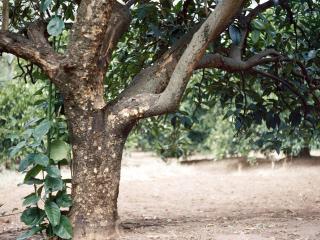Diseases of root and trunk
Armillaria root rot
Citrus trees affected by Armillaria root rot show decline with leaf yellowing and leaf drop. They may set a very heavy fruit crop in spring but collapse and die when the weather gets hot in summer.
Armillaria appears under the bark of affected trees as fan-shaped mycelia mats with a strong mushroom odour.
Long, thin, black strands (rhizomorphs), which look like shoelaces, spread the infection from root to root and plant to plant as they grow through the soil. Originally this fungus was a mild parasite on native trees, stumps and old roots.
In autumn, honey-coloured clusters of mushrooms which are the fruiting bodies of the fungus, appear around the bark of infected trees.
To avoid the disease, clear all remaining stumps and roots well ahead of planting time. To control the disease, isolate infected trees by deep trenching, which breaks the rhizomorphs. If trees are in the early stages of attack, treat them by exposing the roots to air at a distance of 60cm around the butt. Cut off and burn damaged roots.
Do not replace the soil for several years.
Badly affected trees, including the roots, should be removed and burned.
Collar rot
Collar rot is caused by the fungal pathogen Phytophthora citrophthora, which thrives in damp conditions where organic matter on the soil surface is allowed to contact the trunk.
The first symptoms are patches of gum oozing out from the bark around the base of the trunk. The affected bark becomes wet and soft. If it dries out, splitting can then occur. If the organic matter is not cleared from around the base of the trunk the rot will continue to spread until the tree is ringbarked.
To prevent collar rot improve the air circulation near the trunk by keeping it clear of organic matter. Avoid wetting the trunk when watering, and improve soil drainage around the dripzone of the tree. Avoid injuries to the lower trunk and ensure the bud union is well above soil level.
Registered copper fungicides can be applied in autumn as a skirt or under-tree spray. The chemical phosphorous acid applied as a foliar spray will provide protection from Phytophthora infection.
Affected trees should have the lesions cut away into healthy tissue with a sterilised sharp knife. Resterilise the blade with methylated spirits between cuts, before treating the wood under the cuts with a copper fungicide.
Phytophthora root rot
Phytophthora root rot in citrus is caused by the pathogenic fungi P. citrophthora and/or P. nicotianae. Below-ground symptoms are the loss of feeder roots. Above-ground symptoms are a loss of vigour and spindly growth.
As the disease progresses the foliage turns yellow and twigs die back. Phytophthora root rot usually starts at the deeper roots, since these are more likely to be wet, and the fungus is more active in wet conditions. Trees may become more dependent on surface roots, and are therefore more sensitive to drying out.
To prevent the disease consult your local nursery for resistant rootstocks. Ensure that the bud union is 20cm above soil level so the susceptible variety above the graft union does not grow roots.
Water moderately as excessive soil moisture and poor drainage are a major cause of problems. Always use plant material from reputable sources.
Nematodes
Nematodes are microscopic worms that live in the soil. The root knot nematode (Meloidogyne spp.) and the root lesion nematode (Pratylenchus spp.) are the most common nematodes in metropolitan home gardens. However, the most common nematodes affecting citrus trees are citrus nematodes (Tylenchus semipenetrans).
All varieties of citrus are attacked but rootstocks like trifoliate orange (Poncirus trifoliata) are highly resistant to citrus nematode attack. Others such as Troyer and Carrizo citrange are moderately tolerant and some like sweet orange are highly susceptible.
Citrus nematodes are ectoparasitic which means they feed on plant tissues from outside the plant. With their hindquarters buried in the soil, the larvae pierce the roots to feed, usually just behind the growing tips. Feeding on the roots does not kill the citrus tree. However, the root’s capacity to carry water and nutrients is impeded and yields are noticeably reduced early in the life of the tree. Nematode damage of the roots also promotes entry of secondary diseases. Citrus nematodes are most active in the warmer months from September to April.
It is difficult to diagnose attack by citrus nematodes, since they cannot be seen with the naked eye. However, roots that have been attacked usually have a knobbly, gritty, dirty appearance when the soil is shaken from them. This because soil adheres to the sticky egg masses extruded by the females.
Other nematodes need to be identified in a specialised pathogen-testing laboratory. AGWEST Plant Laboratories is the only facility in Western Australia equipped to carry this out. There is a fee for this service.
Nematodes are naturally controlled by a range of pathogens and predators in the soil, including some fungi, bacteria and other micro-organisms. When planting citrus trees make sure your planting material comes from a reputable source, preferably from an accredited nursery.
Diseases of leaves and fruit
Sooty moulds
Fungi that grow on the sweet excretions ‘honeydew’ of sap-sucking insects like aphids, mealybugs or scales are commonly called sooty moulds. Sooty moulds are black and dry and look just like soot. They occur on leaves, twigs or fruits. They don’t damage the plants directly but may block enough sunlight to interfere with photosynthesis. This in turn can stunt plant growth and eventually spoil the appearance of the fruit.
To avoid sooty mould control honeydew-producing insects as well as ants which tend to ‘farm’ aphids and mealy bugs and actively transport them through the garden. An application of horticultural oil will loosen the mould deposits which can be washed from the plant with a jet of water.
Viruses
A number of viruses may affect the growth and yields of citrus trees. However, symptoms are not always obvious. The viruses include scaly butt, citrus cachexia, grapefruit and orange stem pitting virus, psorosis and tatter leaf virus.
Most virus and virus-like diseases can be avoided by the use of virus tested budwood. For disease-free budlines buy budwood from the Australian Citrus Propagation Association (trading as Auscitrus) in New South Wales. Auscitrus maintains blocks of trees that serve as a primary source of disease-free, true-to-type budwood of all important scion and rootstock varieties for Australia’s citrus industry. When purchasing citrus trees, make sure they come from a an officially accredited nursery.

